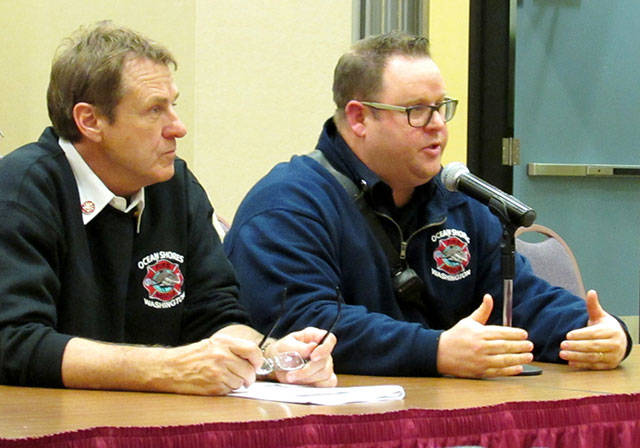The cost of maintaining seven firefighter/medics and emergency medical services overall in Ocean Shores — who pays for it and how much — continues to be the single biggest uncertainty in the 2018 city budget discussions.
As of Thanksgiving week, the City Council was still reviewing a final report by the FCS Group consultants, “Ambulance Utility Cost of Service and Rate Study.” The general idea is to take the financial burden of maintaining emergency medical services out of the general fund portion of the budget and having EMS utility rates pay for non-fire-related services.
“What we really need to take a good hard look at here are the numbers, and what does it take to run the service we have,” Fire Chief David Bathke said.
On the numbers side of the equation, the city budget for 2018 is based on the final conclusion of the service and rate study “status quo” scenario with a projected monthly cost to ratepayers of $19.03, as opposed to the current rate of $7.48 a month.
City Finance Director Angela Folkers noted the figure had increased about $1 a month over the preliminary report because the consultant failed to include the cost of one employee in the initial calculations.
“When we were working through the recommended budget, we felt the need was to keep the seven people,” Folkers said. “We hired this company to do an independent study and give us their recommendations. … Moving forward, we really need to look at how the department was staffed and figure out what are needs are, and this is what they came up with.”
As a result, the city budget currently is based on the assumption the Council will vote separately to raise the EMS utility fee to cover the cost of keeping the firefighters after the federal grant that allowed them to be hired for two years expires.
Council members started to look more closely at the impacts and the decision they would have to make based on the final study, which was delayed several months and revised after the initial public presentation.
“As we grow, we’re going to have a constant push for us to provide adequate service,” said Council member John Lynn. “We can talk dollars and cents all you want, but I think it’s important for our community and to our citizens that they can pick up a phone and someone will be there.”
Holly Plackett asked about some of the details in the study, including the number of multiple calls the department had to respond to on any given date or time.
Bathke noted that of the nearly 2,500 calls last year, 628 times there were either double, triple or as many as four calls for EMS service at once.
“It’s gone up for 2017,” Bathke said.
The chief noted overtime laws make it very expensive to try to staff multiple call situations.
The federal SAFER grant bought the city two years, Bathke said.
“It was a gift, he said. “We have been short-staffed since before the SAFER grant.”
At minimum, the goal is to have six people on duty at any given time at the Fire Station. Ambulance calls require two people, and if there are multiple calls that require trips to the hospital in Aberdeen, the ability to respond to other emergencies is compromised.
“We need to maintain the personnel we have now at a minimum,”Bathke said.
The new report also recommends the department and city do another study to project for future growth and what the need might be. For example, the department currently is unable to staff the smaller fire station at the south end of the city on Marine View Drive, something the chief believes is a growing need during peak times of the year.
“We are going to need to phase in additional personnel on top of the six-per-shift we have now, because we are continuing to grow,” Bathke said. “This study really shows that and hits home, what we need to staff for ambulances.”
Council members will hold another study session on the EMS proposal before a scheduled public hearing on the Ambulance Utility on Nov. 27 at the regular council meeting.
Lynn noted that the Aberdeen EMS rate is $22.80 a month, and Hoquiam charges $19.23.
“We can talk dollars and cents, but we have to remember we have a responsibility to the community to provide adequate coverage,” he said.



